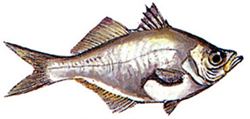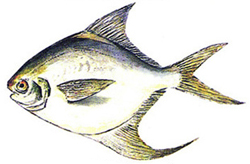Chanda


Chanda members of certain families of Perciformes having a laterally compressed ovoid body with two separate dorsal fins, and usually without Weberian ossicles. Chandas are found both in fresh and marine waters in Bangladesh. The freshwater Chandas are relatively smaller, almost transparent, with minute scales, and occur in rivers, beels, ponds, haors, and baors. During rainy season they may enter rice fields and floodplains.
The three fresh water species are represented by Chanda nama (Nama Chanda), Pseudambassis ranga (Lal Chanda) and P. baculis (Kata Chanda) belonging to the family Ambassidae. An estuarine species Leiognathus equals (Tak Chanda) belonging to the family Leiognathidae can be distinguished from the fresh water forms because of its bright silvery body colour, gray shade along the lateral line, and fine vertical lines from the back to middle of the sides. This species may enter rivers, beels, baors, haors, etc to become permanent fresh water fish. Some medium-sized leiognathids living in the bay of bengal are also known as chanda. Of these Leiognathus bindus is a silver-coloured fish with an olive shade at the nape and with hyaline fins. Leiognathus fasciatus (Dorakata Chanda) have diffuse vertical lines.
The real Chandas or pomfrets (Family Stromatidae) of the Bay of Bengal are represented by Parastromateus niger (Moysa Chanda or Brown Pomfret) and are deep brown or greyish brown with blue reflections, Pampus argenteus (Fali Chanda or Silver Promfret) are neutral grey, and Pampus chinensis (Rup Chanda or Chineese Pomfret) are brownish gray with metallic lustre. Pomfrets are highly relished marine fishes. They are sold fresh, dry, and dry-salted. [Akhtarunnessa Chowdhury]
